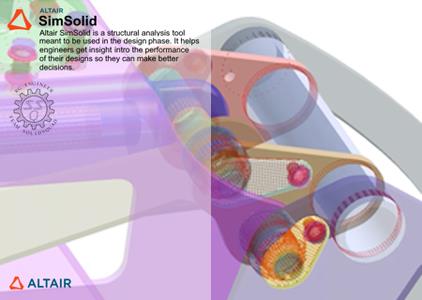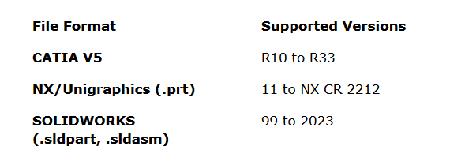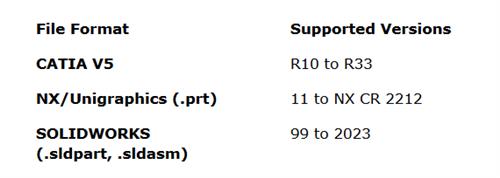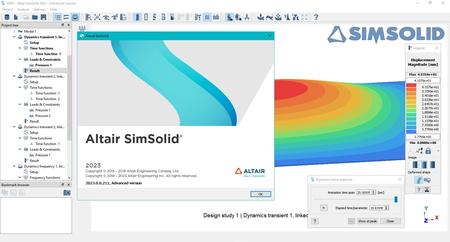- Témaindító
- #1
- Csatlakozás
- 2022.08.02.
- Üzenetek
- 24,048
- Reakció pontszám
- 332
- Díjak
- 6

Free Download Altair SimSolid 2023.0 | 3.7 Gb
Owner:Altair
Product Name:SimSolid
Version:2023.0 with Tutorials & Verification Models
Supported Architectures:x64
Website Home Page :www.altair.com
Languages Supported:english
System Requirements:Windows *
Size:3.7 Gb
The software developer Altair is pleased to announce the availability ofSimSolid 2023.0is a structural analysis software developed specifically for rapidly evolving design processes, enabling the analysis of fully-featured CAD assemblies in minutes without meshing.
Highlights
- Sequential loading with nonlinear geometry
- Imported virtual bushings
- Contour Descriptions in local coordinate system
- Improved solution settings
- Spatial reader
Sequential loading with nonlinear geometry
Structural sequential analysis, where multiple structural analyses can be linked to each other, is now supported for structural non-linear geometric analysis. You can access this function from the Analysis menu, the Analysis workbench toolbar, or by right- clicking on a supported structural analysis to create a linked analysis.
Imported virtual bushings
Virtual bushings under connections can now be imported from a .csv file. To import a virtual bushing; the bushing coordinates, linear and rotational stiffness along all the three axis, and a coordinate system are required. The bushings are mapped based on the specified diameter. It is connected to two parts that fall within the specified diameter from the input coordinates.
Contour Descriptions in local coordinate system
All contour Descriptions for structural and modal analysis can now be Descriptionted along a local coordinate system. The local coordinate system can be Cartesian or cylindrical. The Set Output Coordinate System settings can be accessed from the legend. Pick info and Result graph outputs results based on the output coordinate system.
Improved solution settings
Solution settings have been re-factored to have two higher level adaptations called Global and Global + Local. Global adaptation is best for general load path prediction, modes and/or thermal analysis.
- Uses three adaptive passes and Adapt to thin solids
- Refinement level is set to Standard
- Only uses global adaption
- Uses four adaptive passes
- Adapt to features
- Adapt to thin solids
- Automatically creates local group for the parts and segregates based on its relative volume
- Can be used for both global and local adaptations
- Refinement level is set to Standard
New approach for bolt tightening
Bolt/nut tightening is now performed as active load. The target axial force is now precisely achieved.
Fatigue based on structural nonlinear
Fatigue analysis can now reference structural nonlinear analysis with separating contact. This is supported in addition to structural linear analysis.
Import remote loads with custom coordinate system
Imported remote loads from a .csv can now reference a custom coordinate system in addition to the global coordinate system.
Product editions
Product editions can now be selected from Settings > License. Product editions including Basic, Standard and Advanced are available. In addition to them, a Trial edition is also available that gives access to the Standard version for 30 days.
Re-factor material database
Material database has been re-factored such that materials can be created based on specific physics such as mechanical/thermal. Mechanical properties are not required to be input to just run thermal analysis and conversely.
Re-factor spot welds
Spot welds have been re-factored to represent 2T/3T/4T welds appropriately. All the welds are not converted into 2T welds anymore but are rather represented as created in the Project Tree. When spot welds are imported from a .csv, the order of spot welds is also maintained. In addition to spot weld re-factor, the number of spot welds are also captured in the Project Tree Spot Welds info.
Re-factor boundary conditions for dynamic analysis
You can now apply multiple boundary conditions to the same geometric entity for dynamic analysis. This allows applying different load functions along different directions. Applying multiple load functions to the same boundary condition has now been disabled.
Save RMS response to project file
RMS von-Mises stresses are also now saved to the project file after evaluation.
Solving linked analysis
All linked analysis are solved automatically without using the solve manager. This applies to all linked analysis including structural, buckling, modal prestressed, dynamics, thermal stress and squeak and rattle.
Updated CAD import formats
The list of supported CAD formats are updated.

xAltair SimSolid 2023.0

Close
Updated Teamcenter version
Teamcenter versions 10.0 to 13.4 are now supported.
Spatial reader
A new geometry reader called Spatial reader is supported for CATIA V5 and V6 files. The reader can be picked from Settings > Geometry import settings > CAD reader.
Rotations output to PUNCH file
Rotations are now output to PUNCH file for frequency response analysis.
Rigid body mode cutoff
Cutoff for rigid body modes in dynamic analysis can now be defined. The default is set to 1 Hz.
Known Issues
The following known issues will be addressed in a future release as we continuously improve performance of the software.
- Issues with linear guide joint under virtual connectors.
Resolved Issues
- For dynamic analysis, the entire available modal space is always used instead of just the modes from the frequency span.
- Issues with thermal solution when the boundary conditions are applied to a circular spot.
- Replaced Master and Mate with Primary and Secondary respectively.
- Uniform function in dynamic analysis is now defined across all the frequencies and not limited to 10,000 Hz.
- Issues with SimSolid Plug-in for Fusion.
- Imported temperatures from .csv now use geometry units for the coordinates.
- Issues with approximating imported temperatures.
- Issues with sequential analysis with alignment or inertial loads.
- Replacing a material in the Project Tree with the same material in the material database is now allowed.
- Graphical issues related to model, boundary condition and results displayed.
- Issues synchronizing pick info with contour Descriptions.
- Several geometry reader issues.
- Issues with bolt/nut tightening.
- Issues with corrupted connections when used across multiple design studies.
- Issues handling connections and boundary conditions for deleted/suppressed parts.
- Seam weld creation has been improved.
- Issues Descriptionting reaction forces for alignment boundary condition in nonlinear geometric analysis.
- Issues with reaction forces for multi-loadcase analysis.
- Issues Descriptionting RMS results after refining the result Description.
- Display issues when design studies are copied.
- Several instabilities.
- Several product crashes.

SimSolidis a game-changing simulation technology for designers and design engineers. Its just the perfect tool to kick-start any design process. This software completely eliminates the need for any geometry simplifications and meshing enabling you to get most out of your structural analysis in the least possible time. With SimSolid, model preparation is done within minutes. Even complex parts and large assemblies can be analysed with ease. SimSolid is tolerant of imprecise geometry and is just the right thing to accelerate your design process. In addition, this structural analysis solution is fast, really very fast. Highly accurate simulation results are obtained within minutes! Multiple design scenarios can be quickly analyzed and compared. And, accuracy can be specified on an individual part level allowing a rapid drill down to any level of detail that is required.
Introduction to Altair SimSolid
This video discusses some of the key benefits of Altair SimSolid and contains a detailed demo and product workflow. After viewing this video, you should be able to run your first simulation within the tool
Altairtransforms design and decision making by applying simulation, machine learning and optimization throughout product lifecycles. Our broad portfolio of simulation technology and patented units-based software licensing model enable Simulation-Driven Innovation for our customers. With more than 2,000 employees, Altair is headquartered in Troy, Michigan, USA and operates 71 offices throughout 24 countries. Altair serves more than 5,000 customers across broad industry segments.
Recommend Download Link Hight Speed | Please Say Thanks Keep Topic Live
Code:
⚠
A kód megtekintéséhez jelentkezz be.
Please log in to view the code.
